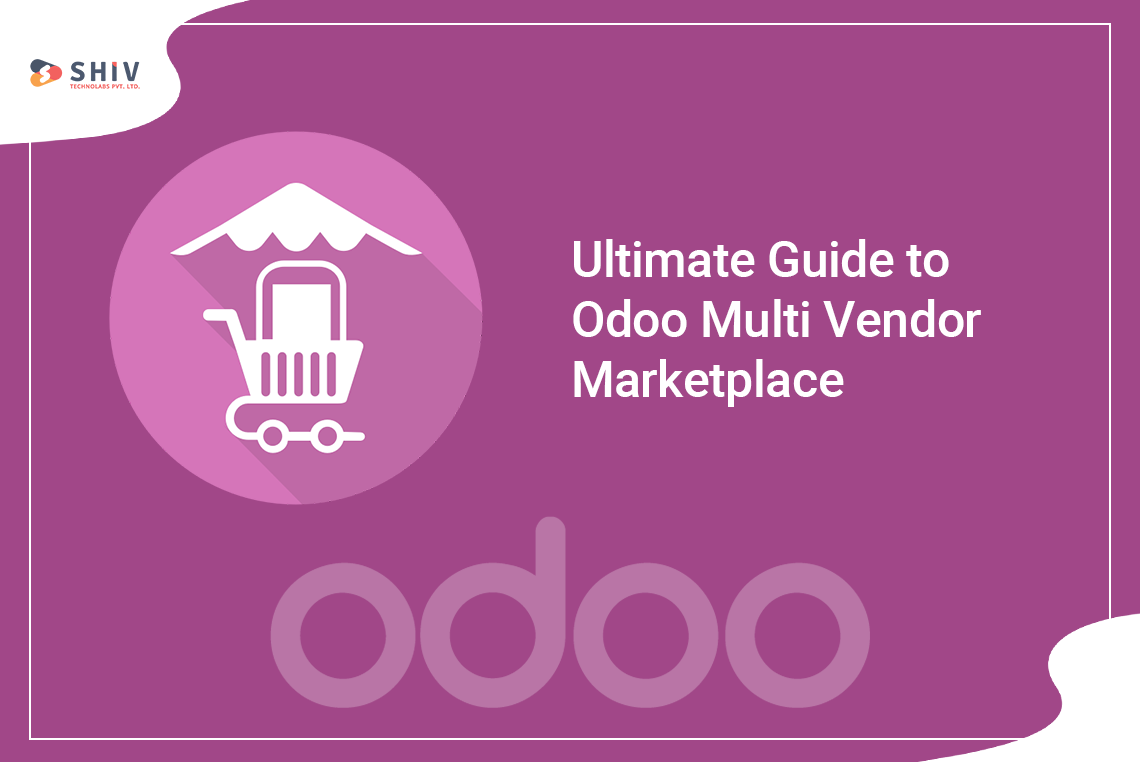Table of Contents
Are you looking for a way to unleash the power of multi-vendor marketplaces without building them from scratch? Think of an extensive online shopping mall where thousands of vendors offer products, attracting many people and growing fast. Sounds too good to be true. What if we tell you it’s not just what you have read but a reality? You’re almost there.
Introducing Odoo Multi Vendor Marketplace – an evolutionary module that can make your simple Odoo website a magnet for vendors. No coding nightmares and technical hiccups; forget them all. Creating a prosperous digital empire has never been easier than with our brand-new Odoo Multi Vendor Marketplace.
What Is Odoo Multi Vendor Marketplace?
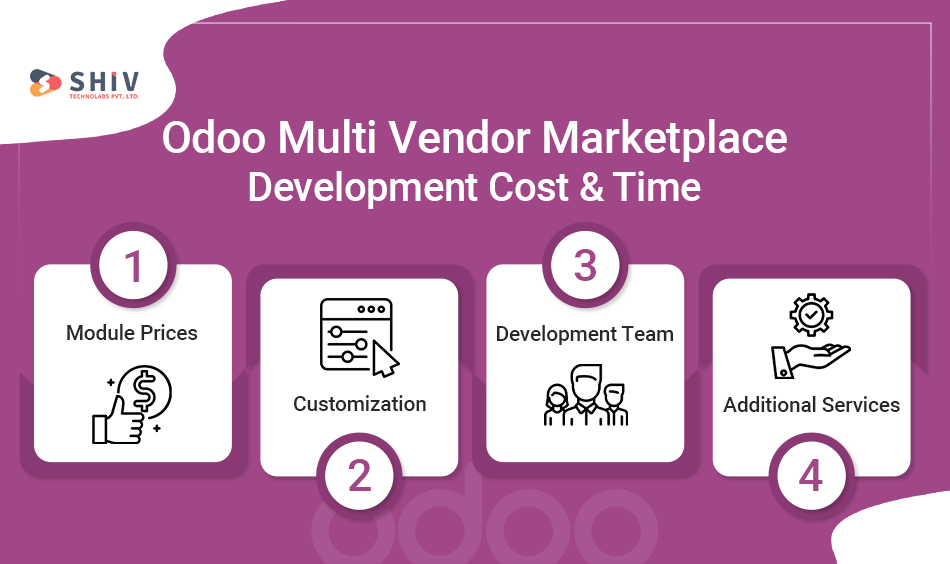
Odoo Multi Vendor Marketplace is a powerful tool that changes your Odoo website into a lively marketplace, permitting many sellers to put up their products and increase your customer base. Vendors can conduct business using vendor dashboards dedicated to order processing, product management, inventory control, and promotional campaigns.
In addition to managing the registration of vendors and policy for commissions, you can also learn more about your business through comprehensive reports. It also helps build a successful online trading empire cheaply without changing other modules in Odoo like CRM, Accounting, and Shipping.
Odoo Multi Vendor Marketplace Development Cost & Time
You can build an online marketplace with the help of Odoo, which is an exciting and rewarding adventure. However, it is imperative to know the costs and timeframes of developing it in order to plan well and budget. Here are some meaningful factors which determine how much you will spend on making Odoo multi-vendor marketplace:
# Main Drivers Of Costs:
- Module Prices: Different prices for several modules in Odoo facilitate functionality within marketplaces. Examples among others are Odoo Marketplace, Multi-Vendor Marketplace, and Marketplace Connector, whose prices range from $299-317.
- Customization: Unique traits and abilities require custom development which significantly affects the cost. Some examples include vendor onboarding, commission management, logistics integration or personalized user interfaces.
- Development Team: Freelancers or agencies hired to develop it can greatly influence the expense incurred. The rates may depend on such issues as location, experience or complexity of the project.
- Additional Services: There might be extra charges for integrating payment gateways or shipping solutions into your site as well as marketing tools.
# Cost & Time Estimation
| Feature | Cost Range | Development Time |
|---|---|---|
| Basic Marketplace (Product Listings, Commissions) | $5,000 – $10,000 | 2-3 months |
| Advanced Marketplace (Vendor Management, Reviews, Payment Gateways) | $15,000 – $25,000 | 4-6 months |
| Highly Customized Marketplace (Unique Features, Mobile App) | $30,000+ | 6+ months |
Key Features Of Odoo Multi Vendor Marketplace
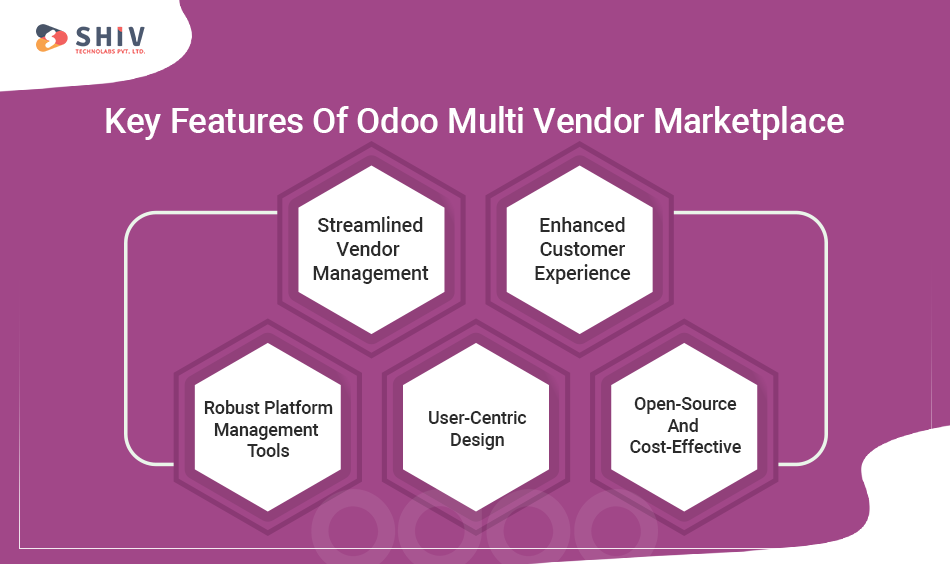
Let’s explore the top five features that make Odoo Multi Vendor Marketplace outstanding:
# Streamlined Vendor Management
- Effortless Onboarding: Forget about complex registration processes because Odoo Multi Vendor Marketplace brings on board vendors through a user-friendly interface, ensuring seamless and smooth partnership.
- Dedicated Vendor Dashboard: Vendors are given control to decide what happens to their items, stock, orders, and performance by being provided with personal dashboards. This will encourage more participation of sellers as well as enable effective oversight of marketplace operations.
- Flexible Commission Structures: Set commission rates that fit your business model. You can create a global rate for all vendors or different rates for specific vendors or product categories. This elasticity ensures fairness to everyone involved.
- Actionable Insights: Get vendor performance indicators, sales trends, and marketplace activities from comprehensive reports available. This will enable you to make good decisions and have an optimized marketplace strategy for better results.
# Enhanced Customer Experience
- Diversity at Your Fingertips: Offer your clients a wide range of products from different sellers, becoming a one-stop shop for them. Such a diversified product catalog keeps the customers engaged and drives the growth of the Marketplace.
- Effortless Product Discovery: Introduce intuitive search and filter functions on your site so customers can easily find their desired items. In addition, this seamless product discovery process enhances customer satisfaction and increases conversion rates.
- Secure and Convenient Checkout: This integrates several trusted payment gateways, making for an uninterrupted checkout experience. When you have such a setup, you provide good customer service and trust in your commerce.
- Transparency Builds Trust: Customers can keep track of their orders and update their details without stress, thus developing trustworthiness. In light of this transparency, customers will stay devoted by making subsequent deals and recommending others to do so.
# Robust Platform Management Tools
- Automated Workflow Engine: Automate repetitive functions such as order confirmation, payment processing, and vendor payouts. With this in place, precious resources and time that can be used for strategy-driven growth are saved.
- Seamless Integrations: Integrate Odoo Multi Vendor Marketplace with other Odoo modules like CRM, Accounting, and Shipping to get the most out of it. Such a platform consolidates all operations into one place, making them as efficient as possible.
- Scalability for Success: Odoo Multi Vendor Marketplace is designed to grow with your business. For this reason, the platform’s scalability allows it to meet ever-changing needs and demands.
- Community-driven Innovation: Utilize the vibrant Odoo community with developers and users who all work together to improve the platform. This open-source method ensures continuous progress and access to new features and functionalities is assured.
# User-Centric Design
- Intuitive Interface for All: Even laypeople can easily navigate the platform. With a user-friendly interface, Odoo Multi Vendor Marketplace enables administrators and vendors to handle their duties easily.
- Brand Your Marketplace: Make your Marketplace represent your brand identity to become unique and create a shopping experience that resonates with your target audience.
- Mobile-first Approach: Accessible via mobile devices such as smartphones and tablets, ensure that you make your Marketplace friendly to all users. This is in line with the ever-increasing trend of mobile commerce, hence offering an uninterrupted experience for customers.
# Open-Source And Cost-Effective
- Free to Use: You can use Odoo Multi Vendor Marketplace without paying any license fees to access its core features. This makes it accessible to any business due to its open-source nature
- Community Support: Countless Odoo users know many subjects. Through this help option, you get instant answers and can optimize the functioning of your site.
- Modular Architecture: Choose the modules and features that align with your specific needs and budget. This costs less compared to having a pre-built marketplace created for you.
Benefits Of Odoo Multi Vendor Marketplace
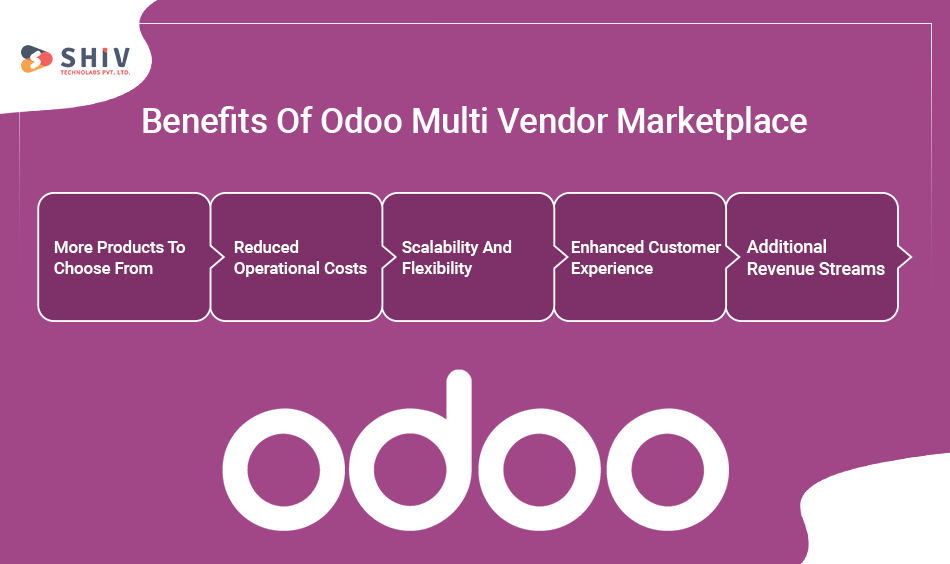
Odoo Multi Vendor Marketplace is a great solution for building an online marketplace that will benefit you and your suppliers. The benefits of using Odoo Multi Vendor Marketplace are:
# More Products To Choose From
When you invite multiple sellers to join your Marketplace, you get more products, which would cater to a wider audience. This means customers can find everything they need in one place, leading to more traffic and sales. In addition, many different types of products exist that can help attract clients who would not have visited the platform otherwise.
# Reduced Operational Costs
Your operational expenses go down because sellers handle their own inventories, order filing, and customer care issues. This allows you to focus on platform development, marketing, and attracting more vendors and helps in long-term growth.
# Scalability And Flexibility
Odoo Multi Vendor Marketplace is designed to grow your business. As your platform expands, performance is easily maintained while accommodating additional vendors and products. Moreover, customization of features and functionalities is enabled by the modular structure of the module based on user preferences and specific needs.
# Enhanced Customer Experience
Odoo Multi Vendor Marketplace is aimed at improving the customer experience. Customers can search and compare prices of items, as well as take advantage of attractive offers. Product reviews, seller ratings, and dispute resolution on this platform fortify clients’ trust and satisfaction.
# Additional Revenue Streams
Odoo Multi Vendor Marketplace has various means through which it can generate revenue. Charging vendors a commission for each sale they make, monthly subscriptions for premium features, or even advertising within the platform are some of the ways that can be used to raise money. These different sources of income contribute towards the financial stability of the site and encourage long-term continuity.
How To Setup Marketplace With Odoo Ecommerce
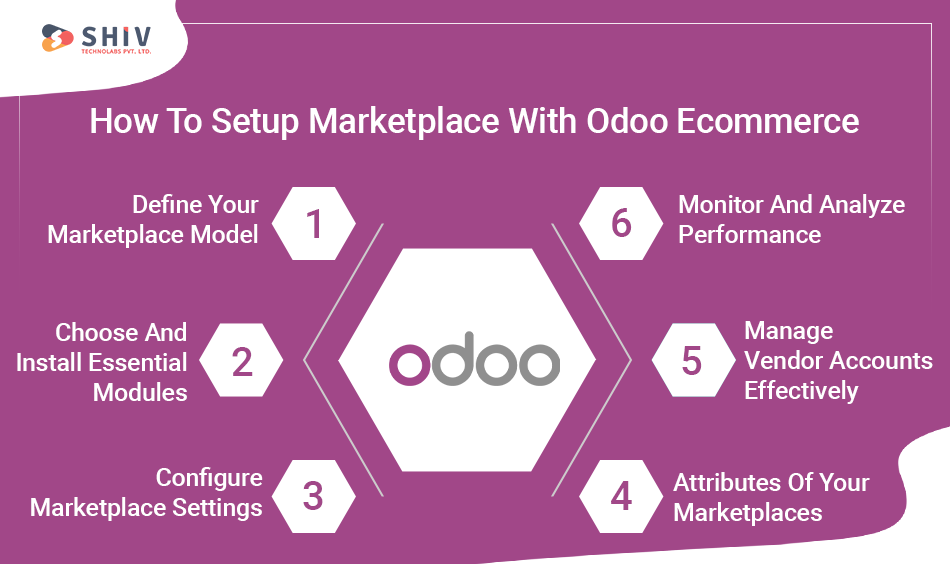
Odoo is a great way to create your online marketplaces, but getting through the setup process might take some work. Here are 6 main tips for you to get started on and guarantee success.
# Step 1: Define Your Marketplace Model
Before moving in, consider the kind of marketplace model you want. Will you be an aggregator who controls inventory and orders, or will your vendors run their own shops and fulfillment? The right model depends on the type of products, vendors’ numbers, and level of control desired.
# Step 2: Choose And Install Essential Modules
Numerous modules can make your Marketplace better in Odoo. The website module allows storefront creation, while the eCommerce module adds product management and payment processing functionality. Also, there is Marketplace, which enables seller registration, commissions, and vendor dashboards. Consider other modules like Product Bundle Pack or Multiple Branch Unit Operation Setup for more specific needs.
# Step 3: Configure Marketplace Settings
To build your Marketplace, ensure you have different commission rates for products or vendors. Establishing workflows for product approval and requirements for vendor registration must take place at this stage. Set up shipping and payment methods relevant to your target audience, too. Also, remember friendly user vendor dashboard customization and shop pages.
# Step 4: Categorize The Products And Customize The Attributes Of Your Marketplaces
Use product templates with dummy information for sellers to fill in to ensure uniformity and make it easy and convenient for them. Introduce Product Approval Workflow to enhance quality control and prevent false listings.
# Step 5: Manage Vendor Accounts Effectively
Review vendor applications and approve qualified sellers who align with your marketplace vision. Set up individual vendor profiles and assign appropriate access permissions for product management, order fulfillment, and customer interaction. Provide training and support to empower vendors and ensure smooth operation.
# Step 6: Monitor And Analyze Performance
Track key metrics like sales, orders, and commission revenue to gauge your marketplace performance. Monitor vendor activity and identify areas for improvement. Analyze customer feedback promptly, addressing any concerns they may raise. Use this data to inform strategic decisions as you optimize your Marketplace for long-term success.
Bonus Tip: Enhance your Marketplace with specialized modules and themes such as Mangopay Connect, which caters to payment gateways, or have a dedicated theme that personalizes the experience for the vendors’ and customers’ sides in the Marketplace.
Conclusion:
Odoo’s multi-vendor marketplace module transforms your e-commerce platform into a dynamic hub for multiple sellers. It empowers you to build a thriving online ecosystem by simplifying vendor management, commission structures, and product approvals. Odoo offers the flexibility and features to scale your e-commerce business and unlock new revenue opportunities, whether aiming for a curated aggregator model or a diverse marketplace platform. Its multi-vendor Marketplace helps you create a successful and sustainable online destination for both vendors and customers in the fierce world of e-commerce.
Frequently Asked Questions (Faqs)
# Is Odoo Multi-Vendor Marketplace simple to use?
The Odoo Multi-Vendor Marketplace is easy to understand and use. It has a user-friendly interface and several other sources of information in the form of help manuals.
# What different types of vendor models does the Odoo Multi-Vendor Marketplace have?
There are two main vendor models in the Odoo Multi-Vendor Marketplace:
- Aggregator Model: Manage product listings, inventory, and orders centrally. Vendors can only update product details and handle orders.
- Marketplace Model: Vendors create shops, manage listings, and handle customer orders directly. You receive vendor applications, decide on the commission rate, and check how well the market operates.
# How much does Odoo Multi-Vendor Marketplace cost?
The price of Odoo multi vendor marketplace varies based on your needs and marketplace size. The minimum price starts at €15 per month for a basic module with additional modules for specific features.

